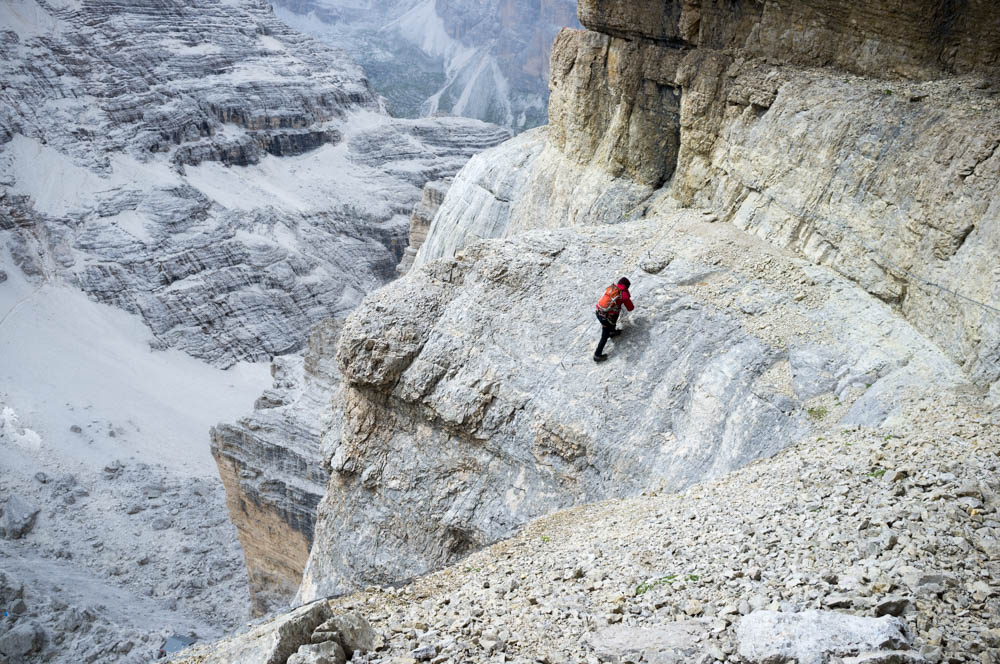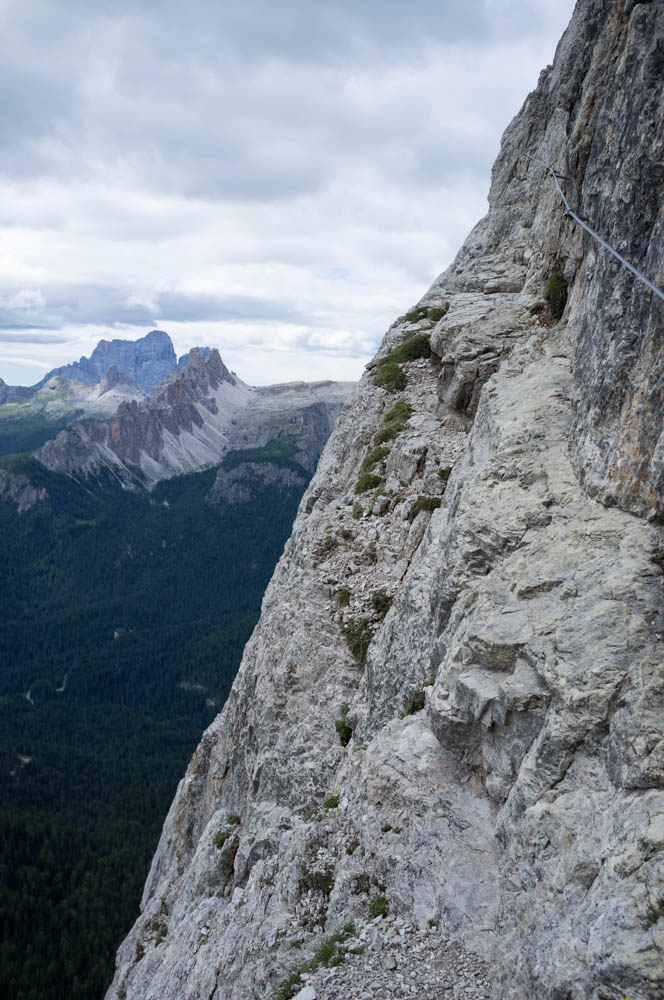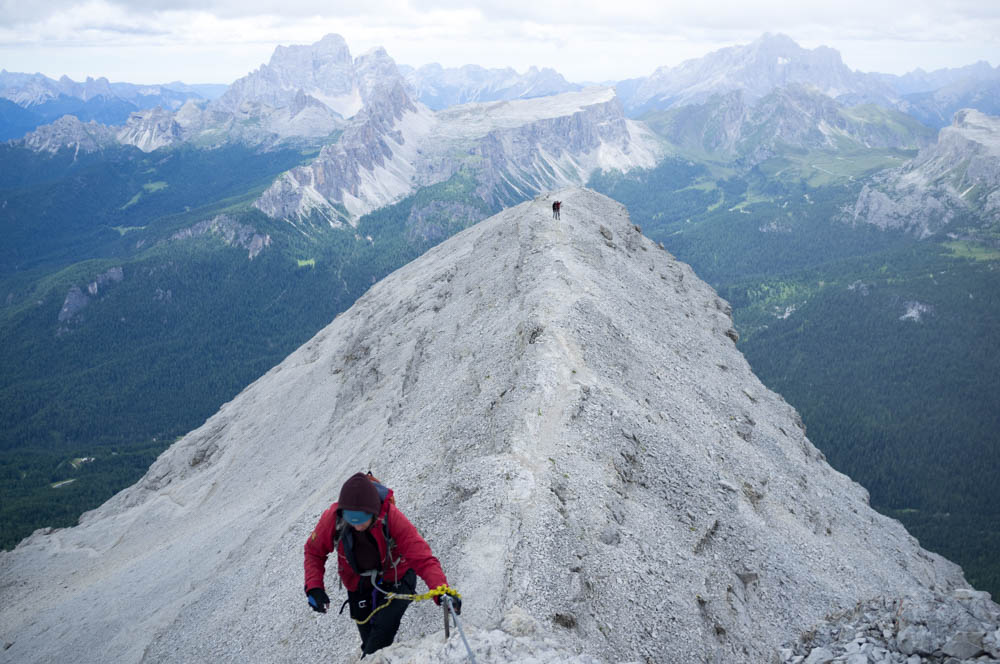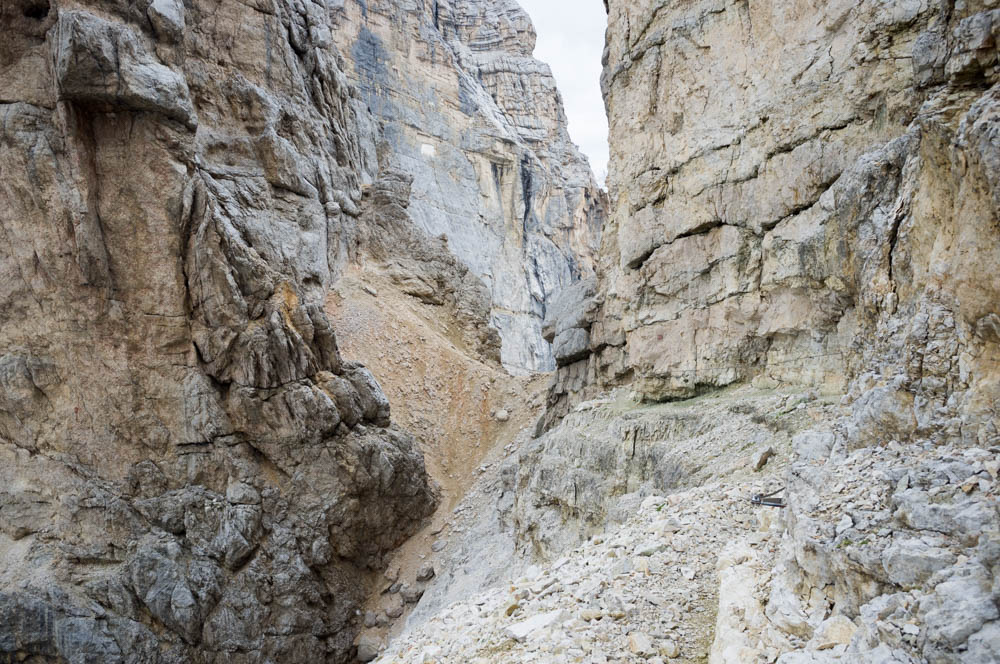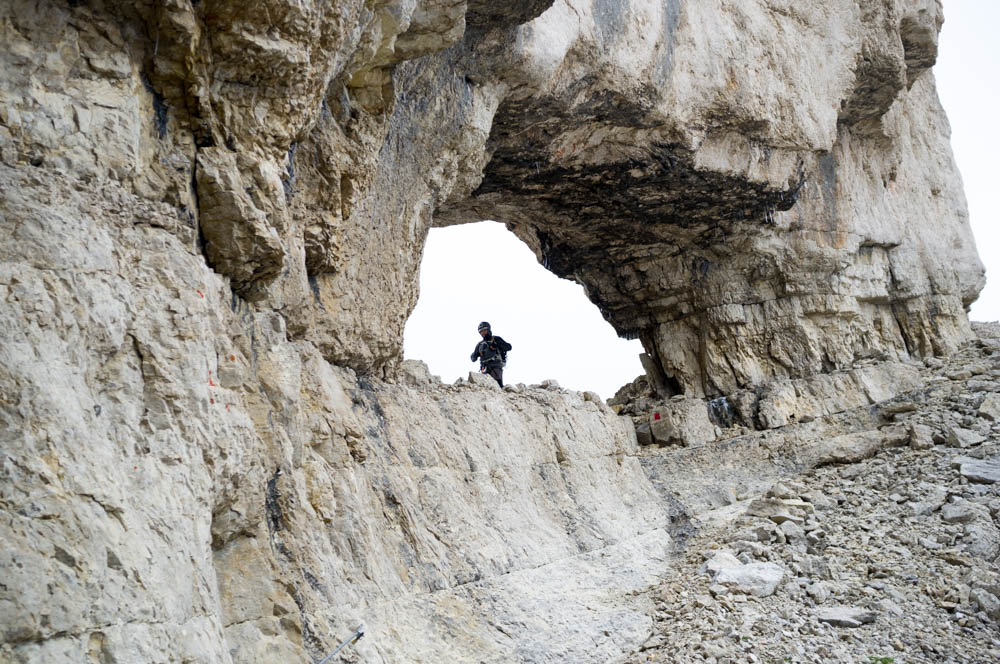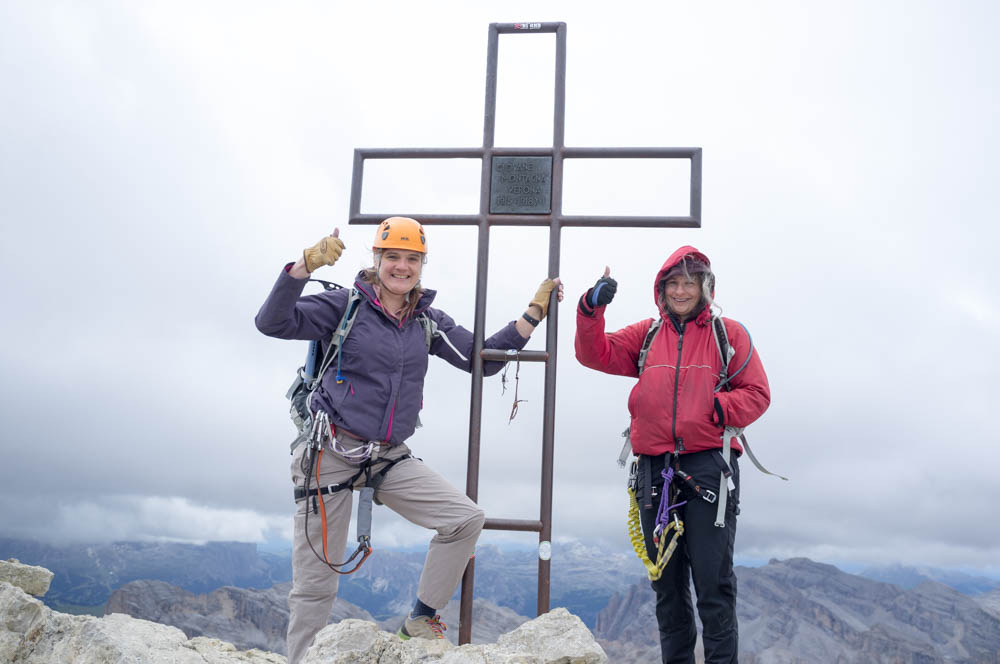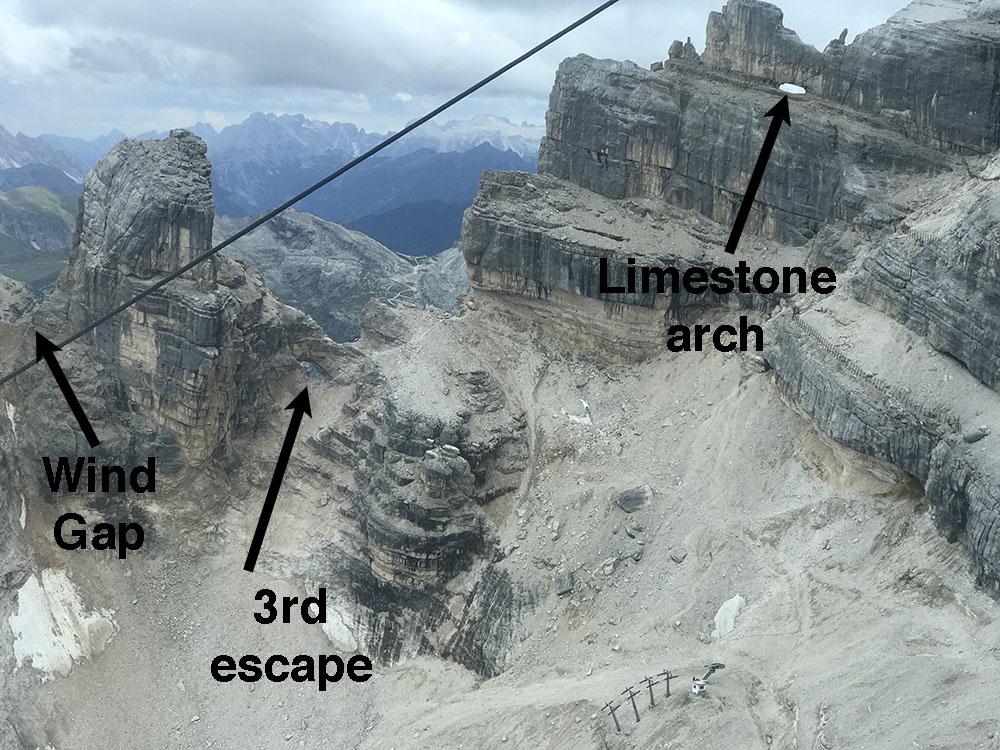This is the via ferrata we wanted to do a few days ago but were scared off by thunderclouds forming on the peaks. It ascends the south ridge of Tofana di Mezzo, the third highest peak in the Dolomites (3044m), initially via the south ride of its subsidiary peak, Punta Anna, and then via the south ridge and nearby east and west flanks of the mighty Tofana di Mezzo itself.
We got an early breakfast, jumped in the car and arrived at the car park at Ristorante Pie Tofana by about 9. Once again we bought singles on the two ski lifts up to Rifugio Pomedes, located where the grassy slopes of the Tofana massif give way to unyielding limestone cliffs, and jumped aboard. It was cold, only about 7º by the time we reached Rifugio Pomedes, and we had our coats on. Aware that snow had fallen over the last day, and that the summit was still above the freezing line, we had brought our ice axes in case we had to cross any big deposits of snow. Thankfully this turned out to be unnecessary.
So about the via ferrata. It’s graded 5C in the Cicerone system, which means it requires both expert climbing skills (the 5 bit) and expert mountaineer skills (the C bit).
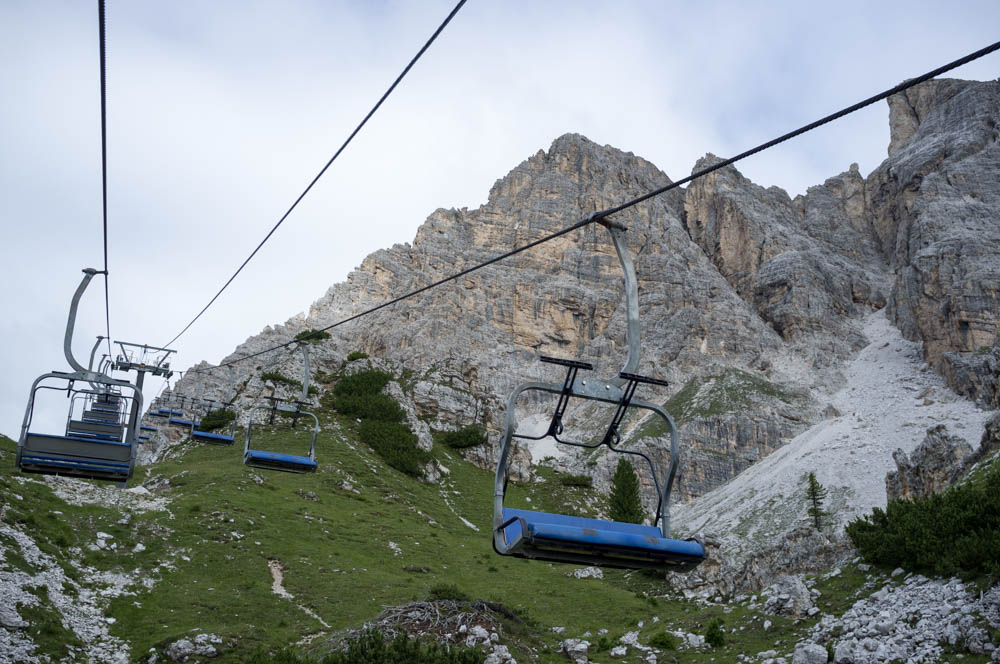
The eastern flank of Punta Anna, one of Tofana’s smaller peaks. The ascent route follows the ridge line.
This is not like the other routes we’ve done so far this holiday. It’s not an excursion on cable up a part of a mountain. This is proper mountaineering. It’s climbing an alp, all the way to the summit, and not an insignificant one either. Tofana is a serious mountain and commands respect. Doing this lightly would be extremely dangerous.
Nobody can quite agree whether this is 2 via ferratas attached end to end, or one big one with escape routes in the middle. It is called three different things on the map: Punta Anna, then Olivieri, and finally Tofana di Mezzo, but increasingly people are just calling the whole thing, “Via Ferrata Punta Anna”. However, lots of people do the lower part of the route (up to Punta Anna) as a half day ferrata, and then either descend down the west flank to Rifugio Guissani, nestled between Tofana di Mezzo and Tofana de Roses, or via a steep path down the slopes of Torre de Pomedes to either the 2nd cable car station of the Tofana cable car (“Freccia Nel Ciello”, which translates to The Arrow In The Sky), or back to Rifugio Pomedes.
This can be a problem because there is a certain time pressure to this VF. The descent from the summit is, realistically, only practical by The Arrow In The Sky. The last cable car departs the summit at 4:50pm. Your options if you arrive after that are either descend on foot (not nice, at all), or sleep in the cable car station (cold, but they leave it unlocked and there is a bunk bed in there).
In fact, the young English couple we met on Sci Club 18 said they miscalculated and made it to the top of this ferrata after the cable car closed. Apparently sleeping in there was very, very cold.
So yeah, you get large groups on the lower part of the ferrata, and they move at the speed of the slowest member. Overtaking is difficult and requires the group to cooperate, which they usually won’t do. If you reach escape point 2 (you only go beyond this point if you intend to summit), after 2pm, you are at serious risk of getting stuck up there.
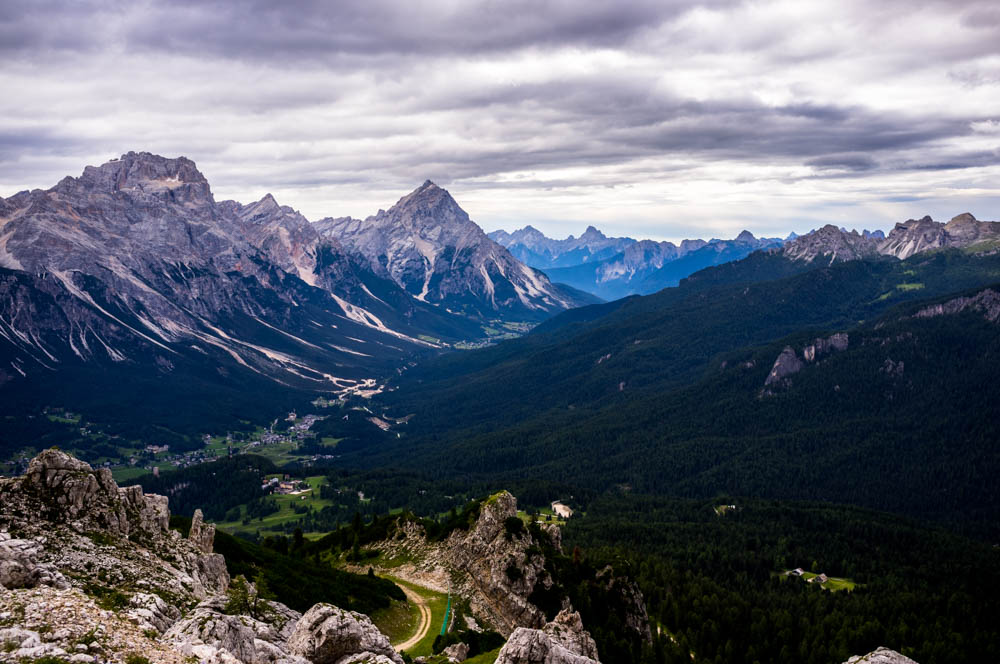
The view down valley from the approach path at Rif Pomedes. Unlike Sunday there are no thunderclouds forming.
That’s why we arrived as early as possible. It turned out that we were the second group to arrive at the approach. The first, as we later found out, were 3 members of the Greek Mountaineering Society. They were quite high on Punta Anna when we got there and it seemed we wouldn’t catch them up (we did, but not until much later). We walked up the steep, but short approach path to the base of the climb and hit the cables at 9:50am.
The initial climb is fairly easy going, and soon leads to an exposed ascending ledge up towards the ridge line. Anyone wanting to do this route had better get used to the exposure because it features a lot. This route is “airy”, seriously so and if heights really bother you, do something else.
As we made our way up the ledge, we noticed another couple starting some way behind us. It turned out that our three groups were the summit club for today. They almost caught us, but not quite. In the event, all 3 groups moved at much the same speed: fast.
The route then has fairly easy climbing towards the ridge line. It’s recently been completely recabled (this was in progress when we last climbed it 4 years ago), and the protection is now excellent, apart from one spot where the peg has come out! It’s at the end of a cable section (the new cabling seems to have frequent breaks, presumably to make overtaking easier), and we couldn’t find the hole it came out of. It must have been taken out in a rockfall. We climbed that bit unprotected: no big deal.
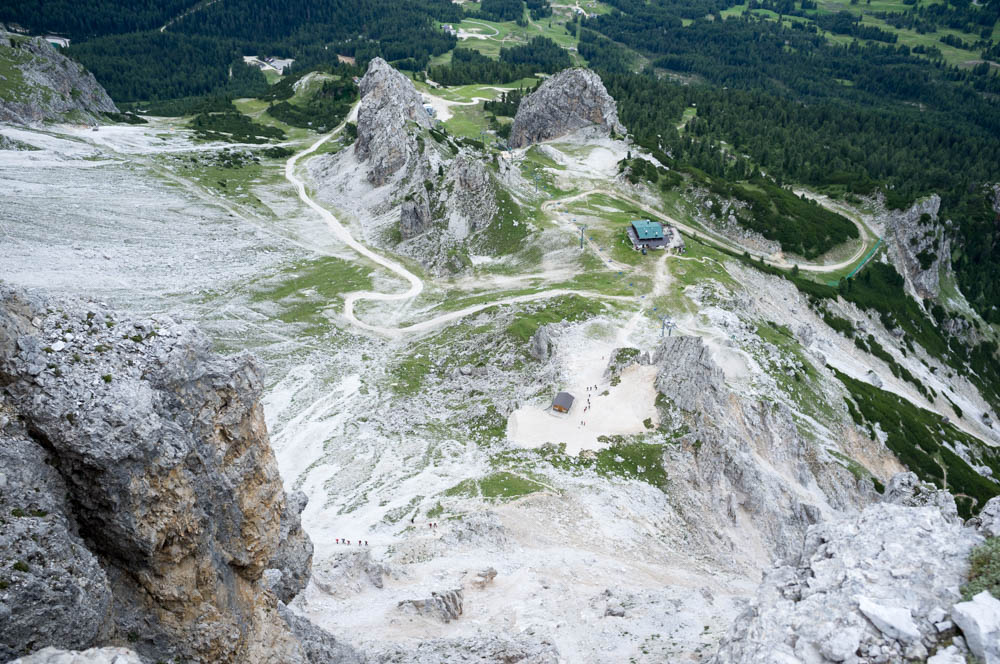
Two huge groups approach the base of the ferrata. That’s why we start early: summit blockers! You might need to click to see the big image to see them.
The route continues to climb towards the ridge line. At about half an hour in, we noticed two massive groups approaching the ferrata from the rifugio. We never saw them again, and presumably they did the first section and then bailed. If we’d got stuck behind them we’d have been screwed.
The route continues to ascend, getting harder as it goes. At about 45-60 minutes in, after it’s taken you onto the western flank, you suddenly reach the crux section. The cable takes you to the ridge line, which at this point is a knife edge, and then forces you to thrust yourself out into space, which hauling upwards on it. At this point there is void on three sides, and a near vertical climb worthy of the Ski Club right in front of you. If the previous bit of exposure made you nervous, this will probably cause a panic attack! It’s possibly the most exposure I’ve encountered on a via ferrata. There’s … nothing, just void, in most directions, and it’s a long way down. I tried to capture this in a photograph but I just can’t do it justice. It’s basically the distilled essence of vertigo.
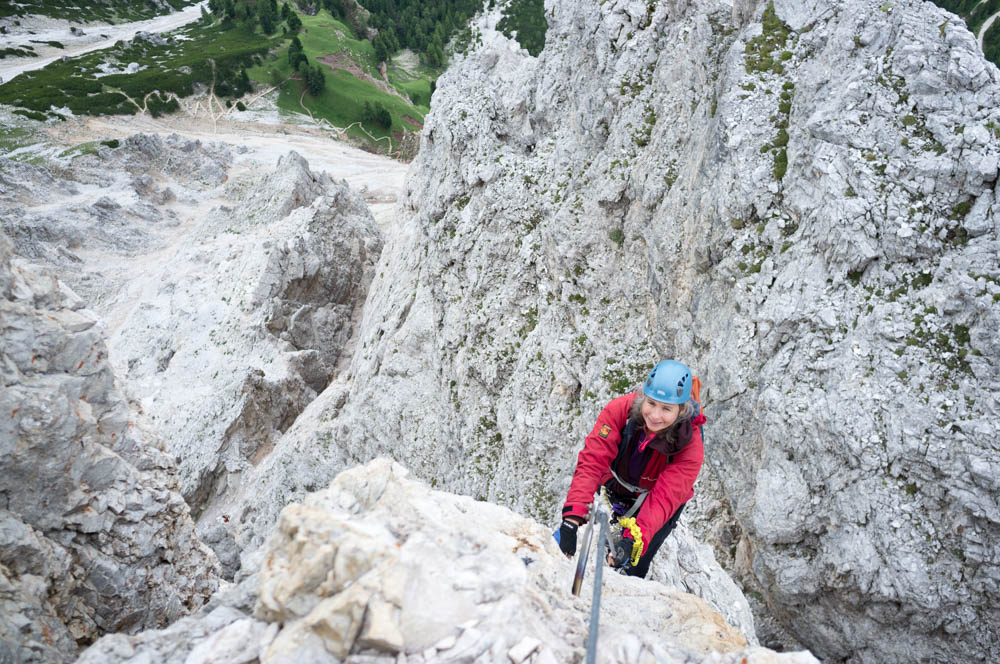
Sylvia on the steep crux section. This photograph does not do it justice. The exposure is hundreds of metres.
The climbing is hard for the next hundred metres or so, and continues to be extremely exposed. As we made our way up, it started to snow (just a few flakes, or as the Cambridge News would call it, “a whiteout blizzard that paralyses the city”). I imagine it was falling in Cortina, fully a mile below us, as rain.
We topped out the crux section, and several more ridge line difficult airy vertical climbs in the gentle snow, which left us on the western flank, near the top. As we approached the summit of Punta Anna (traversing an exposed-as-all-buggery ledge), we noticed the pair behind us had gained a bit of ground and were just coming off the ridge line.
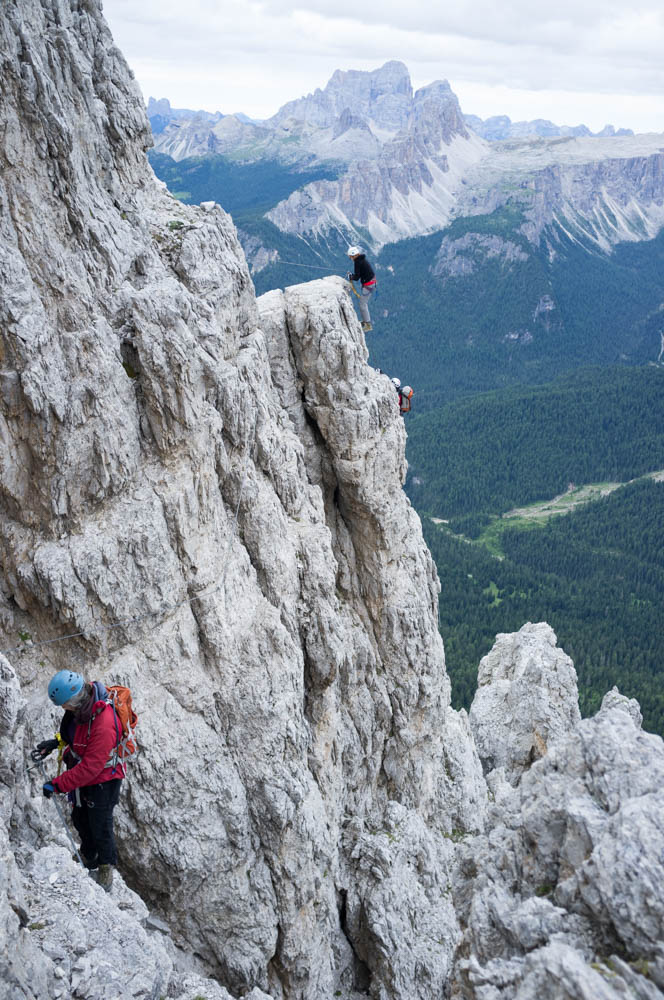
This starts to give you an idea of the exposure, but still doesn’t do justice to the sheer “fuck me, that’s a long way down” nature of it.
The ground soon became much easier as Punta Anna flattened out and approached the point where it joins Tofana di Mezzo’s south face. We were on the western flank at this point, and the strata slopes down, so you have to keep stepping up or you’ll get led down the side of the mountain, possibly onto very dangerous ground. Eventually you come to a fork. This is escape point 1. Left goes down into the pass between Tofana di Mezzo and Tofana de Roses, right continues the ascent.
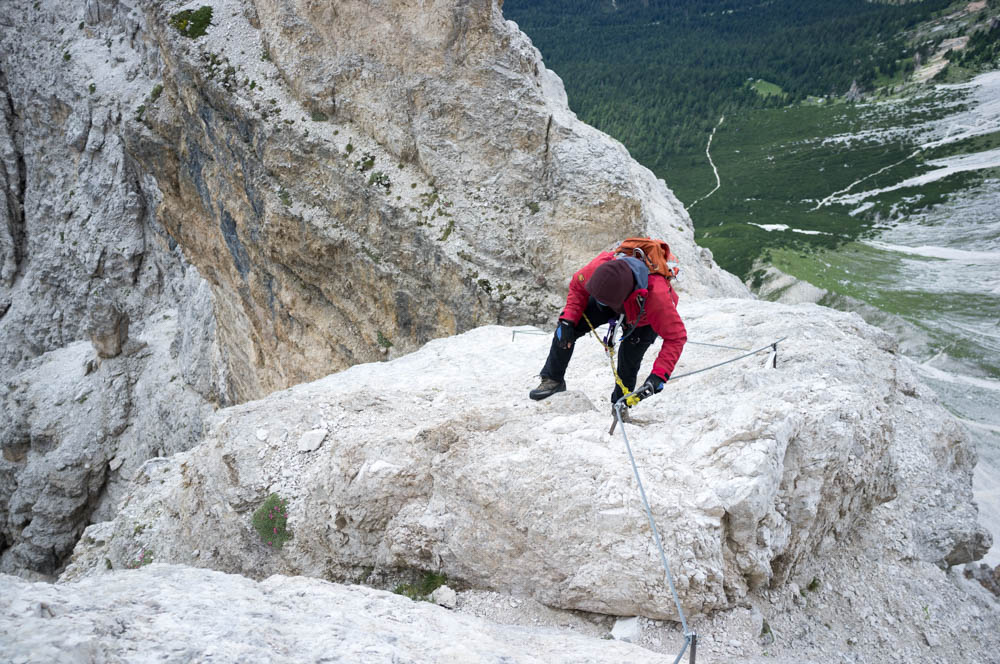
Sylvia on the airy slab. That’s Punta Anna below, in the background. Anyone falling from here would fall for a long time.
A couple of minutes after this sees you start to climb rapidly on an airy (I’m using that word a lot) slab, onto the south face of Tofana di Mezzo itself. It’s steep, but the rock is glorious. It’s also at the point where the prevailing wind gets funnelled up the aforementioned pass and speeds up as it escapes out over the top. This lead to a shouted discussion between us about how strong the wind had to be to blow a climber off their feet and to their doom.
It was also bloody cold. We were approaching the freezing line, being well above 2800 metres by this point.
The slab gets steeper and steeper until it leads to a narrow precarious ledge, with a 500 metre drop to the side. In front of, and slightly below us was the bulk of Torre de Pomedes, coming in to meet the eastern flank of Tofana di Mezzo. Suddenly the ledge spread out at the meeting point on the shoulder of the mountain. The route forked again, with a steep path coming up from the scree slope behind Torre de Pomedes. This is the second escape route and realistically your last chance to leave if you don’t intend to summit. If you treat this as two via ferratas, this is the join.
We stopped and I ate some chocolate. We’d made it here in 2 hours, which was really stunningly good going. For now the route was a walk, turning left and heading straight up the sloping, scree covered east face of Tofana di Mezzo to a path along the ridge. Occasionally there were climbs to be made, but there is nothing like the technical difficulty of the Punta Anna stuff here. Ladders and stemples are provided while you get used to the altitude: you’re close to 3000 metres at this point.
The ridge becomes rocky and the path leaves it, descending slightly down the western flank along a surprisingly wide ledge (Tofana, you spoil us) as we approached the “Wind Gap”. The ridge line turns sharply here and becomes an east facing buttress. There is a gap of about 10-15 metres between that and a cliff face that leads up to the southern summit ridge of Tofana di Mezzo. There’s a scree deposition crossing it, with a narrow path on top and drop-offs to either side.
Oh yeah, and it’s unprotected. As if that wasn’t enough, on the other side we were faced with a sheer cliff which had about 20 metres of strenuous and difficult climbing. Suddenly the technical difficulty of earlier is back, with a vengeance, only this time there’s really not a lot of oxygen. Sylvia mocked me for making loud gurning noises as I hauled myself up, and then promptly did the same.
The next few things happen fast. Suddenly the ferrata forks. The left fork is a short out-and-back to the top of Torrione Gianni, a rock pinnacle with a nice view all around. If there are a lot of people on the ferrata, it’s worth doing this as there will be a queue in front of you for what comes next.
There wasn’t anyone else around, so we proceeded to what is, if not the route’s crux, its crowd pleaser. This is a traverse round Torrione Gianni on cable. There is a 200 metre (at least) sheer drop below you and your feet are on, at best, a ledge that is 10cm wide. In places it vanishes to nothing and you have to step on steel pegs sticking out of the rock. Last time we did this I saw it make grown men deeply frightened. See for yourself, I took video:
Please excuse my heavy breathing. The air is very thin up there and I had to work to get enough oxygen.
Immediately after the traverse, we crossed the top of a limestone arch. This is “the window” and the third and final escape route. It leads down, through the arch, and then down a steep and unpleasant looking scree slope to the pass between Tofana di Mezzo and Tofana de Roses, far, far below. I wouldn’t want to use it.
From here, you can see the summit cable car station, deceptively close.
What happened next confused us. In 2013, when we last did this, the route pretty much stopped being a ferrata and turned into a scramble up a large bowl on Tofana’s east face, climbing up scree through old battered avalanche fences. This time, a painted arrow directed us round and down, just next to the window, onto the western flank.
The moment I started to descend I was hit fully in the face by a wind that was driving frozen rain and pelting me with it. This was unpleasant, but didn’t last long. The path led to a completely new section of ferrata with some fun climbing on the west flank. This is far better than the previous route, and makes my favourite ferrata even more rounded.
The top of this climb took us to a big limestone arch, with icicles hanging from its roof. It was here we caught up with the Greek climbing team, who were impressively far ahead when we started 4 hours previously.
Once through the arch and up a shiny new ladder, we rejoined the old route (we could see a bit of the old ferrata coming in from the left) which still has the last of the previous cabling. It’s in a bad way and I hope they replace it soon. It’s also not very long and leads to an unprotected scramble for the summit. This would be very easy were we not at 3200 metres and, in the thin air, finding it very hard work.
20 minutes or so scrambling and then we come up to a fence. This is the limit of the little walkabout area around the summit from the cable car station. We’d done it! We scrambled the last little bit to the summit cross, where the Greeks were kind enough to take our photo.
From the summit cross, it was a short walk down to the upper cable car station where, after walking past the bunk bed by the entrance and sniggering, beer was waiting.
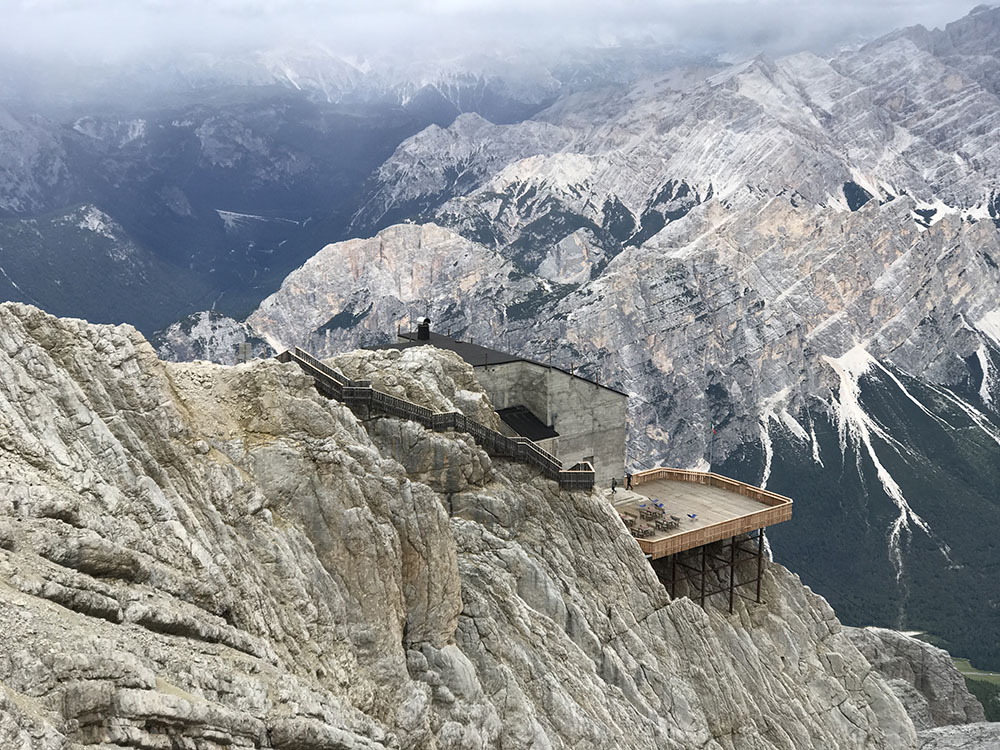
The upper cable car station, and bar. This is where James Bond met his contact in “For Your Eyes Only”!
We had ascended a thousand metres to 3244m above sea level: the third highest mountain in the Dolomites. It had taken us 4 hours and 40 minutes, beating the guidebook time by 50 minutes. Given that the guide book was written by two disturbingly fit German mountain guide hero types, and we’re a couple of bumbly middle aged women from the flatlands, we felt justifiably proud of that. We drank our beer and looked out at Cortina, over 2 vertical kilometres below us.
Beer duly drank and ferrata kits duly packed into our bags (this is one rifugio one can feel perfectly justified wandering into still kitted up), we bought tickets to descend 2 of the 3 cable lengths to Col Drusié, stepped into the Arrow In The Sky and started to descend. This afforded us a great view of the last bit of our route:
If you look carefully, you can see some of the avalanche fences below the limestone arch.
The air got thicker and warmer very quickly. My ears popped every few seconds. Then we were approaching the intermediate station at Rifugio Ra Vales. The attendants quickly ushered us into the car for the central section of the Arrow In The Sky, and we continued our descent. A couple of minutes later we were at Col Drusié. Any further and we’d end up in Cortina. Instead we exited the station, walked a short distance down the road (it’s a ski piste in winter), and found ourselves at the chairlift where we’d bought one way tickets 7 hours earlier. The car was right where we left it.
Back to the hotel and straight into the sauna. We climbed an alp, a big one, and it was awesome!
